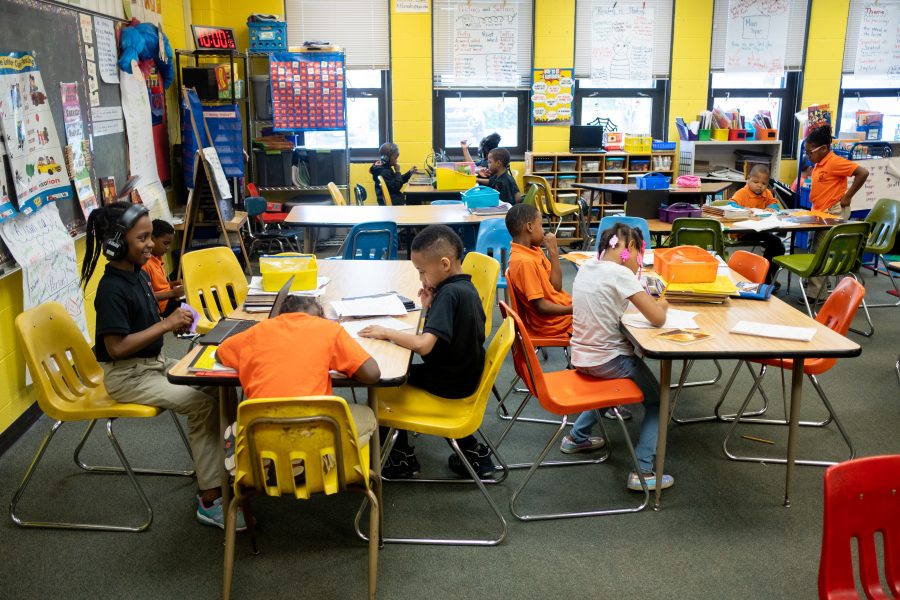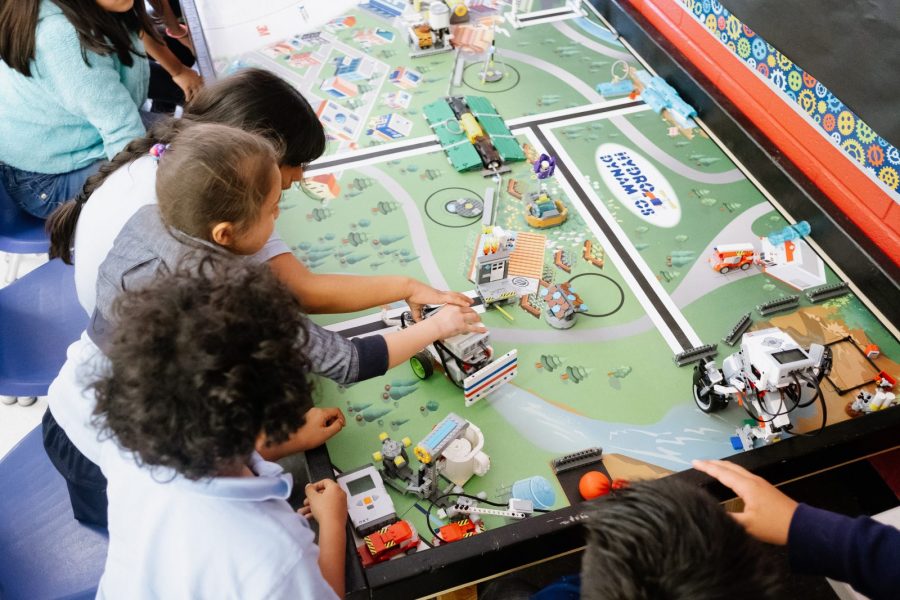Learner Led
Learners are entrusted to take ownership of their learning.
41%
increase in skills among children who were taught self-monitoring over children who were not
Schunk, D. H. (1982). Progress Self-Monitoring.
The Journal of Experimental Education, 51(2), 89–93.
The Journal of Experimental Education, 51(2), 89–93.
How Do Learner Led Experiences Help Students?
When students lead and feel in control, they work harder to learn. This is the case whether or not they meet their goals.
Still, teachers know they must strike a balance between giving students autonomy and supporting them to develop crucial skills and knowledge—because students need to feel confident and competent before taking greater control of their learning.
Still, teachers know they must strike a balance between giving students autonomy and supporting them to develop crucial skills and knowledge—because students need to feel confident and competent before taking greater control of their learning.

The Guidelines of Learner Led
Learners articulate their needs, strengths, and interests.
Encourage and model articulation of needs, strengths, and interests to inform future learning.
Show Example
Example: A teacher provides his learners with a “Reflection Binder.” At the end of each day, they reflect on their work, identifying what worked well for them, what they struggled with, and what support they need.
Show Strategy
Offer tools to help learners identify their own needs, strengths, interests, and preferences (e.g. interest inventories, checklists, reflection exercises).
Show Example
Example: Over the course of six weeks (beginning at the start of the school year or when a new learner arrives), teachers and learners complete several inventories to identify learning drivers and gaps.
Show Strategy
Establish a culture that encourages learners to actively share their feelings and experiences while learning.
Show Example
Example: A teacher creates a system of small book clubs and public share-outs during independent reading time that helps the community of learners share their excitement for books.
Show Strategy
Provide learners with a systematic method (e.g. learner profiles) for documenting learning needs and preferences.
Show Example
Example: A teacher uses a platform for learners to regularly update their needs, strengths, and interests in focus areas to inform conferences, interventions, and/or upcoming lesson plan design.
Show Strategy
Guide learners to generate questions that lead to further curiosity and self-directed learning.
Show Example
Example: A teacher does a KWI (Know, Wonder, Interest) chart to have learners share what they know, wonder, and are interested in regarding a theme.
Show Strategy
Learners partner in setting their learning goals.
Collaborate with learners to set specific, challenging short-term goals and develop learning plans.
Show Example
Example: An advisory teacher has learners craft a daily goal at the start of each day that is reviewed among their peers at the end of the day.
Show Strategy
Support learners to imagine a desired future and then think through what challenges they will need to overcome to attain it.
Show Example
Example: A teaching team has learners complete a WOOP (Wish, Outcome, Obstacle, Plan) template at the start of each month.
Show Strategy
Partner with learners to establish a timeline and a plan for monitoring progress in meeting goals.
Show Example
Example: A teacher meets with a learner to set dates on which the learner will finish key steps toward a long-term project. They also include days that she will get feedback from a peer or teacher.
Show Strategy
Utilize mentor conferences to review progress and determine next steps.
Show Example
Example: A classroom has a system of “learning buddies,” or peers that regularly check in with each other on goals and learning plans for reading.
Show Strategy
Learners partner in shaping their learning pathways and experiences.
Collaborate with learners to develop standards-aligned activities that meet their learning goals.
Show Example
Example: At the start of the week, learners complete a shared online document that outlines their proposed activities for the week. The teacher reviews the plans and provides guidance as necessary.
Show Strategy
Allow learners to choose their best learning place and medium to work on their goal.
Show Example
Example: During an ELA block, two teachers open up their doors and create one quiet and one “active conversation” room that students can choose between for their work.
Show Strategy
Enable learners to choose with whom to work based on goals and needed expertise.
Show Example
Example: A class creates a peer working group and identifies adult mentors for their upcoming projects.
Show Strategy
Offer learners an organized approach to outline and document their learning plan (e.g. template, rubric).
Show Example
Example: A teacher provides learners with a template to plan and track their learning activities for the week.
Show Strategy
Empower learners to choose their own approach to learning a new concept.
Show Example
Example: A teacher empowers her learners to choose between 10-blocks, tallies, and other mediums for learners to practice their math.
Show Strategy
Learners assess, monitor, and reflect on their progress.
Guide learners in ongoing reflection on learning outcomes, products, and processes.
Show Example
Example: A teacher provides time at the end of every rotation for learners to complete a template for reflection on what they learned and what they find challenging.
Show Strategy
Provide learners with ongoing access to their data to help identify academic and non-academic needs.
Show Example
Example: A teacher has learners track their growth in skills (via assessment scores) in a binder, so they can see which of their skills are strong and which skills they need to work on.
Show Strategy
Partner with learners to reflect upon and document their own learning needs and progress.
Show Example
Example: A teacher helps learners create a system to track and reflect on their progress in an edtech product.
Show Strategy
Model examining data, discussing progress and identifying challenges, as well as needed supports.
Show Example
Example: A teacher meets with a learner and models how to look at the learner’s data to identify areas of progress and areas where the learner needs support.
Show Strategy
Help learners reflect upon their learning strategies and efforts, as well as the result of those strategies and efforts in regard to meeting desired learning goals.
Show Example
Example: A teacher helps a learner reflect on her use of a reading strategy, and then the learner chooses to try a new strategy from a given list.
Show Strategy
Learners advocate for needed support from teachers, peers, technology, and other sources.
Coach and model for learners how to identify and advocate for their needs according to degrees of urgency.
Show Example
Example: A teacher works with his class to create anchor charts that give suggestions for how learners can know if they need support and provides prompts for how to ask for help.
Show Strategy
Actively encourage learners to independently problem-solve by seeking help from peers, technology, and other sources.
Show Example
Example: A teacher establishes a classroom culture of “Three Before Me,” in which learners must seek help from three other sources before consulting the teacher.
Show Strategy
Establish routines for regular learner-led conferences.
Show Example
Example: A teacher sets up a rotation of short, five-minute check-ins with learners throughout the week for them to vocalize their progress and needed supports. Experienced learners teach others how to be more effective in learner-led conferences.
Show Strategy
Actively nurture a class culture of self- and team advocacy.
Show Example
Example: A teacher guides learners to reflect on their rights and identify barriers to their learning. Learners then work individually or as a collective group to advocate to the proper authorities for changes or expanded privileges.
Show Strategy
Provide a system for learners to provide their status and request support.
Show Example
Example: A teacher gives each learner a popsicle stick and flag to decorate. When the learner needs assistance, he/she places it in the “up” position to notify the teacher and peers that help is needed.
Show Strategy
What Does the Research Say?
A disconnect between what is taught in school and what interests students drives a decrease in motivation and achievement, notably among boys. Thus, giving students more say in what they learn can play an important role in increasing motivation, attention, and learning—even when the material is challenging.1
Student grades, attendance, and conduct improve when they practice a learning technique where they imagine a desired future, think through potential challenges and then plot a course to surmount those challenges. However, this practice is not widespread, so there have been no systematic reviews of personal development or learning plans.2
Studies are mixed on whether students learn more from student-led projects or ones led by teachers. This is largely because few models are purely one or the other; the best classrooms embrace a hybrid where teachers and students collaborate on desired projects, and students get more choice in everyday activities.3
Student grades, attendance, and conduct improve when they practice a learning technique where they imagine a desired future, think through potential challenges and then plot a course to surmount those challenges. However, this practice is not widespread, so there have been no systematic reviews of personal development or learning plans.2
Studies are mixed on whether students learn more from student-led projects or ones led by teachers. This is largely because few models are purely one or the other; the best classrooms embrace a hybrid where teachers and students collaborate on desired projects, and students get more choice in everyday activities.3

1. Learner Led Guideline #1
Learners articulate their needs, strengths, and interests
2. Learner Led Guideline #2
Learners partner in setting their learning goals
3. Learner Led Guideline #3
Learners partner in shaping their learning pathways and experiences
